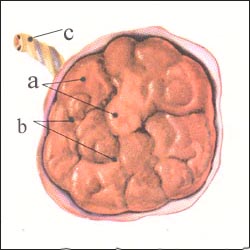
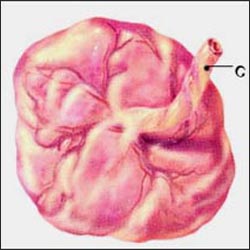
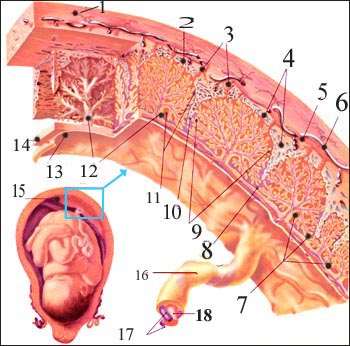
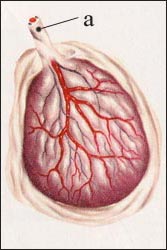
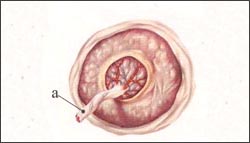
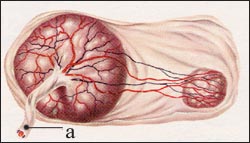
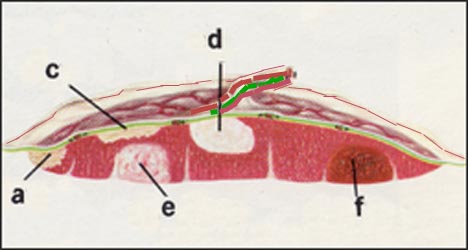
Copyright ⓒ 2014 John Sangwon Lee, MD., FAAP
Labor stage III in the third stage of labor 분만 3기
As soon as the second stage of delivery is over, the third stage of delivery begins. Immediately after the baby is born into this world, the placenta attached to the wall of the uterus completely falls off the wall of the uterus.
The entire process in which the fallen placenta and amniotic membrane are completely discharged from the vagina through the birth canal is called the third stage of delivery. The appearance of the placenta is also referred to as postpartum (後産).
It takes about 10 to 30 minutes for the third stage of labor to start and end.

The normal surface of the placenta attached to the wall of the uterus a-umbilical cord, b-placental lobe, c-placental lobe septum Source-Clinical Education Aid #2 Ross Laboratories, Columbus, Ohio 43216

The normal placenta surface on the side that the fetus was in contact with c-umbilical cord Source-Clinical Education Aid #2 Ross Laboratories, Columbus, Ohio 43216

Blood circulation in the placenta 1-uterine muscle layer, 2-superior deciduous membrane, 3-linear artery, 4-venous sinus, 5-uterine artery, 6-uterine vein, 7-nutritional germ layer, 8-?, 9-capillaries , 10-superior deciduous septum, 11-chorion, 12-live chorion, 13-amniotic membrane, 14-chorion, 15-?, 16-umbilical cord, 17-umbilical vein Source-Clinical Education Aid #2 Ross Laboratories, Columbus, Ohio 43216 Abnormal placenta that resembles a Western raised body shape a-umbilical cord Source-Clinical Education Aid #2 Ross Laboratories, Columbus, Ohio 43216



Abnormal main stroke placenta a-umbilical cord Source-Clinical Education Aid #2 Ross Laboratories, Columbus, Ohio 43216 Abnormal minor placenta a-umbilical cord Source-Clinical Education Aid #2 Ross Laboratories, Columbus, Ohio 43216
Immediately after the baby is born, the period until the placenta attached to the wall of the uterus completely comes out of the vagina is called the third stage of delivery.
After the second stage of delivery, that is, even after the baby is discharged, the uterus continues to contract little by little and the placenta falls off the uterine wall and comes out of the vagina.
After that, the size of the uterus, which was enlarged by pregnancy, gradually decreases to the size of the uterus before pregnancy.
The placenta comes out of the vaginal cavity in the uterus by the contraction of the uterus and by gravity. In the third stage of delivery, the placenta can come out more easily if you sit at an angle than if you are lying still.
It is common for the placenta to fall from the wall of the uterus in the third stage of delivery and blood from the wall of the uterus to which the placenta was attached. If you gently rub the lower belly before the placenta comes out, the placenta can come out more easily, and the amount of uterine bleeding can be reduced right after the third stage of delivery.

The placenta may become older and unable to function properly after the due date of delivery. If the placenta comes out for one reason or another, you should investigate whether the placenta is normal. a-marginal local ischemia, c-villi plaque, d-white degeneration, e-fibrous ischemia Source-Clinical Education Aid #2 Ross Laboratories, Columbus, Ohio 43216 Copyright ⓒ 2014 John Sangwon Lee, MD., FAAP
“부모도 반의사가 되어야 한다”-본 사이트의 내용은 여러분들의 의사로부터 얻은 정보와 진료를 대신할 수 없습니다.
“The information contained in this publication should not be used as a substitute for the medical care and advice of your doctor. There may be variations in treatment that your doctor may recommend based on individual facts and circumstances.
“Parental education is the best medicine.“